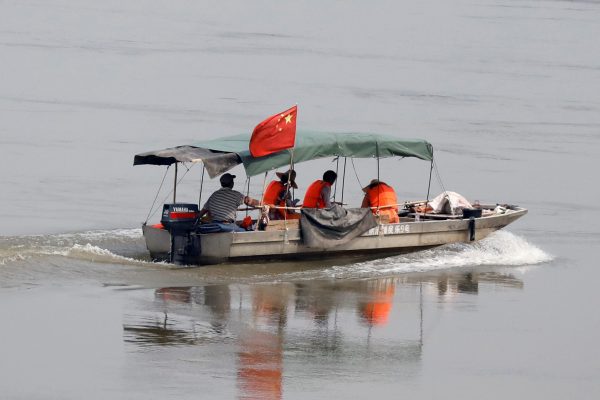Put bluntly, the Mekong River region represents a crucial testing ground for Beijing’s mid- to long-term ambitions — not acknowledged officially — to become the hegemon in East Asia and possibly beyond.
This is in part because the Mekong River region is situated in China’s immediate vicinity. The region is comprised of mostly small countries amenable to influence but with great strategic importance. China is also the river’s most upstream riparian, with more than 10 mainstream dams completed or under construction. The geographic and economic advantages over the other Mekong countries have already made China the Mekong’s quasi-natural hegemon.
The key question for China’s leaders is how to best perform this hegemonic role. One of the primary objectives of a hegemon is to ensure compliance. Four mechanisms can be identified to achieve this: coercive, utilitarian, normative and ideological.
China makes use of a mixed but interlinked strategy that seeks to avoid open coercion of the Mekong river states. First, China most visibly relies on a utilitarian approach that offers economic and financial incentives to meet diplomatic ends. To no small extent, this approach is also driven by domestic rationales, especially China’s intention to develop its remote south-western regions and provide them with access to new markets. Over the 2000s, China rapidly emerged as the top trader, investor and donor in the Mekong River region, spurring much of the economic growth there.
The Belt and Road Initiative (BRI) has further bolstered China’s status in the region as it includes the China–Indochina Peninsula Economic Corridor — one of the six main BRI corridors. Consequently, the countries in the Mekong River region have, to varying degrees, become economically dependent on China. This is particularly true for Laos and Cambodia, but even Vietnam, not generally China-friendly, is struggling.
Second and more recently, China has additionally engaged in a normative approach — signing treaties and building institutions — to protect its position as hegemon. Over the course of the 1990s as China’s renewed interest in the Mekong River region slowly gathered speed, it was still confronted with a predetermined institutional order dominated by Western actors and Japan. The founding of the Lancang-Mekong Cooperation (LMC) in March 2016 reflects China’s growing desire to exercise greater authority over the region. The mechanism boasts a comprehensive agenda, exclusive membership for all Mekong riparian countries and enormous financial resources from which they can draw.
While the LMC should do much more in terms of codifying rules and procedures for cooperation, the mechanism still has the potential to eclipse other firmly established regional bodies. This includes the Mekong River Commission and the Asian Development Bank-led Greater Mekong Subregion (GMS), let alone smaller venues like the US-driven Lower Mekong Initiative or the Japan–Mekong Summit.
Third and finally, China has long been anxious to sell its goals and actions in the Mekong River region under the benign slogan of ‘common development and prosperity’. This persistent rhetoric belongs to an attempt at discursive knowledge construction, which not only aims at the acceptance of China’s authority, but also at the internalisation of China’s values and norms. It has steadily evolved into a sanctioned discourse presented as a win-win strategy without alternatives. Highways and railroads for enhanced connectivity and dam building for increased energy supply are the examples of the narrative that touts all-out economic progress as a panacea.
Yet despite China’s great efforts, not everybody in the region has bought into China’s rhetoric as there are many that do not benefit from China’s behaviour. This is especially true for the large number of local communities that make their living directly from the Mekong’s resources.
These communities continually challenge China’s preferred discourse, turning China’s dam-building activities into a particularly controversial issue. Blaming China’s dams for current low water levels is the latest episode of an enduring counter-narrative that questions China’s sincerity. It also seeks to shift attention to urgent ecological matters, illustrated by the motto ‘We want to eat fish, we cannot eat electricity.’ But these local communities do not always enjoy governmental support, making it impossible for them to effectively challenge Beijing’s strategy. This is particularly true in Laos and Cambodia where — often China-sponsored — dam building is high on the national agenda.
For China’s leaders, the status quo means that their hegemonic project in the Mekong River region is not yet accomplished. The recent US–Japan announcement to set up a joint Mekong Power Partnership indicates that powerful external players are willing to remain involved in the region and present it with an alternative to China.
China must choose between two distinct forms of hegemony. One is characterised by positive leadership, particularly through the creation of fairly distributed public goods and the inclusion of all actors in decision-making processes. The other is narrowly focused on domination and self-interest. These two forms are similar to the Chinese terms wangdao (benevolent rule) and badao (despotic rule).
While being a hegemon is not easy, China’s leaders can still do much more to tip the scales in favour of the virtuous wangdao in the Mekong region.
Sebastian Biba is a Research Fellow at the Institute for Political Science, Goethe University Frankfurt.

